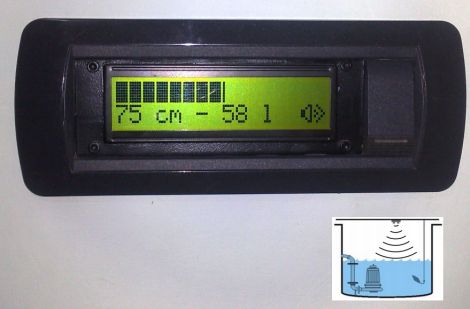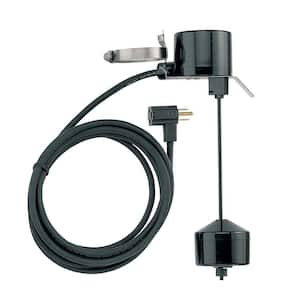Vertical level switches
Hi there all
I am currently working on a design of a very small self watering garden, and want to find an effecient way to switch a small pump on and off. Even the 15 minutes of mechanical timers is too long, and the cost of a fancy programmable jobby is not going to make the unit sensible in terms of sales potential. I need to fill a small overhead water canister that will then drain to the planters a few times a day. I have been looking at these little vertical level switches as an option
I can get them in South Africa too, but have never used one before. Are they reliable? What are the do's and don'ts (eg particles in water) that I need to know about as the specs on the online shops are sketchy.
Tags:
Replies to This Discussion
-
Permalink Reply by Vlad Jovanovic on September 12, 2011 at 6:20pm
-
Kobus,
Here is a really well written tutorial/how to, that explains exactly how Rick's Arduino micro processor works, while the second link explains how you would use it with a simple Relay, how you would connect them, and why they work that way...
http://yourduino.com/pins-bits-1-0-.htm
-
Permalink Reply by Rik Kretzinger on September 12, 2011 at 9:19pm
-
Kobus - this might be an option for you also. After I finish up on some other projects I want to give this a try.
Monitoring water levels with a Parallax Ping sensor

When you need a mechanism to detect the water level within a container or tank, you have several different options. Most people opt for a simple float or probe that sits in the water, while others use optics to sense when the water is reaching an undesired level.
This device built by [Danilo Abbasciano] uses a Parallax Ping sensor instead. If the sensor is placed at the top of a well, cistern, or other water container, it can accurately calculate the height and volume of the fluid inside. This is done by using the Ping’s readings in conjunction with a few values already known to the user, namely the dimensions of the container.
In his implementation, the readings are relayed to a simple LCD panel for easy viewing, and a small piezo speaker is used to sound an alarm when the water level reaches a predefined threshold. This sort of measuring device can be quite useful in situations where a contact-based sensor would be subject to chemicals and corrosion, or where contamination is a concern.
-
Permalink Reply by Kobus Jooste on September 13, 2011 at 12:25am
-
Hey all
Thanks for the fantastic suggestions coming through. Many of these will undoubtably work well, and I'll be looking at incorporating something on the more simple side into my design to begin with. Not sure about the US, but over here, the resession has been an even bigger excuse for people to try to pay less than honourable prices for your efforts in putting something together. I worry that the kind of price tag coming with a basic control system will scare people off, but I will explore further.
-
Permalink Reply by Jon Nose on September 13, 2011 at 12:57am
-
Maybe you can setup a small holding tank with water regulated so that it fills up slowly, have a bell siphon that feeds into the system that you want to water.......
-
Permalink Reply by Kobus Jooste on September 13, 2011 at 1:17am
-
Jon, this is the "low cost" option that I am working with now. I wanted a reservoir with water containing a pump filling the holding tank, which would then drain into the different planters of the unit. without a timer swith of "affordable" specs, it will have to have a return flow drain to the reservoir, fill for the 15 minute cheap timer cycle, and then flood the beds as you described (roughly in any case). This is a soil based design still (I'm slowly building people into aquaponic concepts step by step) thus there are no need to worry about fish health or anything. It is simply a self-contained soil garden that only needs the main reservoir filled periodically. The more expensive option would have the vertical switch in the overhead tank to simply switch the pump off when it is full.
-
Permalink Reply by Vlad Jovanovic on September 13, 2011 at 5:16am
-
Kobus,
I don't know if this qualifies as 'low cost enough', but a one channel relay for an Arduino micro processor costs $3.50USD, while the microprocessor is $25.00USD
http://arduino-direct.com/sunshop/index.php?l=product_list&c=11
2-4 and 8 channel relays can also be had for a few dollars more (allowing you to control your pump, lights, a wall outlet, etc...in addition to your float switch)...
Kobus Jooste said:Jon, this is the "low cost" option that I am working with now. I wanted a reservoir with water containing a pump filling the holding tank, which would then drain into the different planters of the unit. without a timer swith of "affordable" specs, it will have to have a return flow drain to the reservoir, fill for the 15 minute cheap timer cycle, and then flood the beds as you described (roughly in any case). This is a soil based design still (I'm slowly building people into aquaponic concepts step by step) thus there are no need to worry about fish health or anything. It is simply a self-contained soil garden that only needs the main reservoir filled periodically. The more expensive option would have the vertical switch in the overhead tank to simply switch the pump off when it is full.
-
Permalink Reply by Harold Sukhbir on September 13, 2011 at 7:20am
-
Hi Kobus,
This is a float pressure switch. Works like a toilet valve with stem and ball to turn on the pump at high level and shut off at lower arc of the ball arm( be careful if ordering as there are 2 types-top shut off or bottom shut off) . When I was looking at these I realized that this type of operation will not be ideal for our conventional submersible pumps(they wear with repetitive on/off) but will be more suitable for regular in-line pumps. This one cost approx USD $40.00 and is super reliable but the links I sent you previously, with the DIY are far less costly.
-
Permalink Reply by Kobus Jooste on September 13, 2011 at 8:24am
-
Thanks Vlad. IF I was able to get it here at exactly that price, it would translate into a top of the range modification for the system, which is what I am hoping for. A base model without full timer control and a top end with it.
Vlad Jovanovic said:Kobus,
I don't know if this qualifies as 'low cost enough', but a one channel relay for an Arduino micro processor costs $3.50USD, while the microprocessor is $25.00USD
http://arduino-direct.com/sunshop/index.php?l=product_list&c=11
2-4 and 8 channel relays can also be had for a few dollars more (allowing you to control your pump, lights, a wall outlet, etc...in addition to your float switch)...
-
Permalink Reply by Kobus Jooste on September 13, 2011 at 8:26am
-
Thanks Harold - was there a link with the previous post as there are none made with your reference here though.
Harold Sukhbir said:Hi Kobus,
This is a float pressure switch. Works like a toilet valve with stem and ball to turn on the pump at high level and shut off at lower arc of the ball arm( be careful if ordering as there are 2 types-top shut off or bottom shut off) . When I was looking at these I realized that this type of operation will not be ideal for our conventional submersible pumps(they wear with repetitive on/off) but will be more suitable for regular in-line pumps. This one cost approx USD $40.00 and is super reliable but the links I sent you previously, with the DIY are far less costly.
-
Permalink Reply by Harold Sukhbir on September 13, 2011 at 8:47am
-
Sorry Kobus,
Here http://www.acehardwareoutlet.com/productDetails.aspx?SKU=49553
-
Permalink Reply by Vlad Jovanovic on September 13, 2011 at 9:17am
-
I dont know if these are of some help...
http://www.netram.co.za/index.php?option=com_virtuemart&page=sh...
http://www.fort777.co.za/index.php?main_page=index&cPath=800_1234
Netram sells the Arduino UNO for 270R and you wont have to deal with customs ;)
Kobus Jooste said:Thanks Vlad. IF I was able to get it here at exactly that price, it would translate into a top of the range modification for the system, which is what I am hoping for. A base model without full timer control and a top end with it.
Vlad Jovanovic said:Kobus,
I don't know if this qualifies as 'low cost enough', but a one channel relay for an Arduino micro processor costs $3.50USD, while the microprocessor is $25.00USD
http://arduino-direct.com/sunshop/index.php?l=product_list&c=11
2-4 and 8 channel relays can also be had for a few dollars more (allowing you to control your pump, lights, a wall outlet, etc...in addition to your float switch)...
-
Permalink Reply by TCLynx on September 13, 2011 at 12:10pm
-
Here is the kind of low tech float switch I figured might be appropriate.
 When the float hits the bottom of the rod, it pulls the switch down and when the float hits the top of the rod it pushes the switch up. Now I don't know if this particular model is easy to flip around to change if up means on or off but the one I have I think I could flip the switch part over under the housing so it could turn a pump on when the float hit the bottom and then turn the pump off when the float got to the top. I have already done things like replace the rod with a different length before.
When the float hits the bottom of the rod, it pulls the switch down and when the float hits the top of the rod it pushes the switch up. Now I don't know if this particular model is easy to flip around to change if up means on or off but the one I have I think I could flip the switch part over under the housing so it could turn a pump on when the float hit the bottom and then turn the pump off when the float got to the top. I have already done things like replace the rod with a different length before.Biggest problem with this sort of float switch is the Gross Mechanical Nature of it. You need to allow the float to move freely up and down but also make sure it doesn't float out to the side (mine runs up and down in a gravel guard that is wedged in place.) They can certainly fail or become entangled so make sure overflows are in place in case of failure.
If you were to just get the switch part and do your own basic wiring and make your own float and stuff, I'm sure this could be fairly cheap.
- ‹ Previous
- 1
- 2
- 3
- Next ›
© 2025 Created by Sylvia Bernstein.
Powered by
![]()